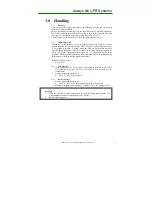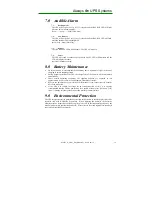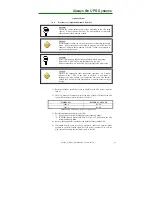
Always
O
n UPS Systems
Optional Extras
10.4.
Procedure for (Optional) Extended Batteries
Attention:
Choose the correct battery pack voltage, according to the UPS rated
capacity. Do not connect too few or too many batteries, as this could
cause electrical shock, damage or death.
Caution:
It is important to follow the correct procedures for connecting the battery
packs. If the procedures are not followed properly, it will increase the
chance of electrical shock, damage or death. Follow the procedure to
avoid any possible danger.
Attention:
Ensure correct battery bank voltage and polarity before connecting.
Ensure UPS is “OFF” and battery fuse/breaker(s) are “OFF”
Do not connect the wires to the UPS first, electrical shock might occur.
Caution:
Observe the appropriate cable connections regulation (e.g. National
Electrical Code – NEC in the USA) at all times. Using cables of
improper size may damage your equipment and cause fire hazards.
Ground the UPS and the load equipment to a common point to prevent
looping.
1)
Batteries should be installed as close as possible to the UPS system (no more
than 6’).
2)
The DC Voltage of the batteries must be the same as the DC Voltage of the UPS
system. The battery voltage is provided in Table 11.1.1.
MODEL NO.
BATTERY VOLTAGE
1000VA 36VDC
1500VA 36VDC
Table 11.1.1
UPS battery voltage configurations
3)
Before connecting the batteries to the UPS:
i)
You Must power down the UPS and remove input AC supply.
ii)
If present: Battery Breaker MUST BE in the “Off” position on the UPS
system and Battery Bank.
4)
Battery cable (supplied) is attached to the Battery Cabinet and the UPS.
5)
If multiple battery banks have been purchased connect all batteries banks
together in a parallel fashion (Batt. Pos. to Batt. Pos. and Batt. Neg. to Batt.
Neg.) before connecting the final battery bank to the UPS.
M0301_N_Series_DM_Manual V1.4 2012-06-12
18






































